Incredible Stories of Invention: How Mistakes Led to Genius
Throughout history, some of the most groundbreaking inventions have emerged from unexpected errors and mishaps. From the microwave oven to the humble Post-it Note, these innovations are proof that even mistakes can pave the way to genius. This blog post delves into remarkable stories of invention born from mistakes, offering insights into how serendipity, combined with a keen eye for opportunity, can lead to incredible breakthroughs.
The Power of Serendipity in Innovation
Serendipity, the occurrence of events by chance in a beneficial way, plays a significant role in the world of invention. According to a study published in the Journal of Product Innovation Management, approximately 35% of inventions and innovations are serendipitous. This statistic highlights the importance of keeping an open mind and being receptive to the unexpected.
The Microwave Oven: A Happy Accident
Perhaps one of the most famous examples of accidental invention is the microwave oven. In 1945, Percy Spencer, an engineer working for Raytheon, was testing a magnetron, a device used in radar technology, when he noticed that a candy bar in his pocket had melted. Intrigued by this phenomenon, Spencer conducted further experiments, eventually leading to the development of the microwave oven. Today, microwaves are a staple in 90% of American households, revolutionizing how we cook and heat food.
Penicillin: A Contaminated Petri Dish
In 1928, Alexander Fleming, a Scottish bacteriologist, returned from vacation to find that a petri dish containing Staphylococcus bacteria had been contaminated by a mold. Rather than discarding the dish, Fleming observed that the mold was inhibiting the growth of the bacteria. This mold, later identified as Penicillium notatum, became the basis for penicillin, the first true antibiotic. Penicillin has since saved millions of lives and is regarded as one of the greatest discoveries in medical history.
From Sticky Situations to Sticky Notes
In the 1960s, Dr. Spencer Silver, a chemist at 3M, accidentally developed a low-tack adhesive while attempting to create a strong one. This “failure” eventually led to the creation of Post-it Notes, a product that has become indispensable in offices and homes worldwide. The story of Post-it Notes underscores the importance of not discarding ideas that seem to fail at first glance.
The Role of Experimentation and Persistence
Many accidental inventions are the result of persistent experimentation and a willingness to explore unconventional ideas. Thomas Edison, for example, famously said, “I have not failed. I’ve just found 10,000 ways that won’t work.” Edison’s approach highlights the value of perseverance and the understanding that each “failure” is a step closer to success.
Velcro: Inspired by Nature’s Mistake
In 1941, Swiss engineer George de Mestral went for a walk with his dog and noticed that burrs kept sticking to his clothes and his pet’s fur. Intrigued, he examined the burrs under a microscope and discovered tiny hooks that caught onto loops in the fabric. This observation led to the development of Velcro, a versatile fastening system used in countless applications today, from clothing to aerospace technology.
Actionable Tips for Embracing Mistakes as Opportunities
While not every mistake will lead to a groundbreaking invention, adopting a mindset that embraces errors as opportunities can foster innovation. Here are some actionable tips:
- Stay Curious: Cultivate a habit of questioning and exploring the unexpected. Curiosity can lead to new insights and creative solutions.
- Document Everything: Keeping detailed records of experiments and outcomes can help identify potential opportunities hidden within mistakes.
- Encourage a Culture of Experimentation: In both personal and professional settings, create an environment where experimentation is encouraged, and failures are seen as valuable learning experiences.
- Collaborate and Share Ideas: Engage with others to gain different perspectives and insights. Collaboration can often lead to innovative solutions.
Conclusion: Embracing the Unexpected
The incredible stories of invention highlighted in this post demonstrate that mistakes, when viewed through a lens of curiosity and persistence, can lead to astonishing breakthroughs. By embracing the unexpected and learning from errors, we can unlock new pathways to innovation and creativity. So, the next time you encounter a mistake, remember: it might just be the first step toward your next genius invention.
For more inspiring stories and insights into the world of innovation, subscribe to our newsletter and stay updated with the latest content.






Leave a Reply
You must be logged in to post a comment.